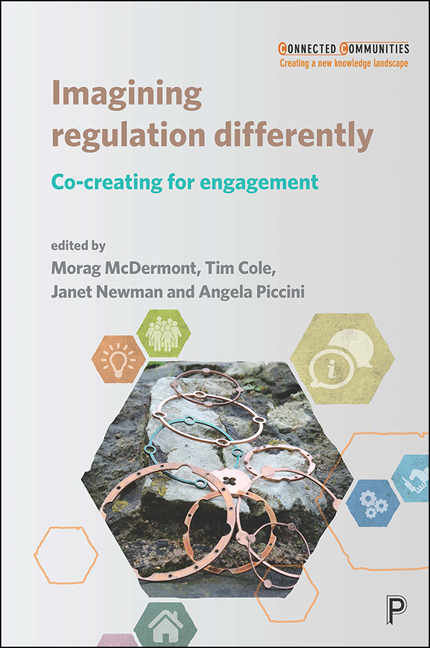Book contents
- Frontmatter
- Dedication
- Contents
- List of Figures, Tables and Boxes
- List of Abbreviations and Acronyms
- Notes on Contributors
- Acknowledgements
- Series Editors’ Foreword
- 1 Introduction: From the Regulation of Engagement to Regulating for Engagement
- 2 Co-Production as Experimentation: the Research Forum as Method
- Interlude: Community Researchers and Community Researcher Training
- 3 Beyond Prevent: Muslim Engagement in city Governance 49
- 4 Regulating for ‘care-ful’ knowledge Production: Researching Older People, Isolation and Loneliness
- 5 Who Gets to Decide what’s in my Fridge? Principles for Transforming the ‘Invisible Rules’ Shaping the Regulation of Food Habits in Urban Spaces
- 6 Life Chances: Thinking with art to Generate new Understandings of Low-Income Situations
- 7 The Making, Mapping and Mobilising in Merthyr Project: Young People, Research and arts Activisms in a Post-Industrial Place
- 8 Regulating Engagement Through Dissent
- 9 The role of Community Anchor Organisations in Regulating for Engagement in a Devolved Government Setting
- 10 Conclusion: Towards an Organic model of Regulating for Engagement
- Postscript: Engaging the University?
- References
- Index
1 - Introduction: From the Regulation of Engagement to Regulating for Engagement
Published online by Cambridge University Press: 03 March 2021
- Frontmatter
- Dedication
- Contents
- List of Figures, Tables and Boxes
- List of Abbreviations and Acronyms
- Notes on Contributors
- Acknowledgements
- Series Editors’ Foreword
- 1 Introduction: From the Regulation of Engagement to Regulating for Engagement
- 2 Co-Production as Experimentation: the Research Forum as Method
- Interlude: Community Researchers and Community Researcher Training
- 3 Beyond Prevent: Muslim Engagement in city Governance 49
- 4 Regulating for ‘care-ful’ knowledge Production: Researching Older People, Isolation and Loneliness
- 5 Who Gets to Decide what’s in my Fridge? Principles for Transforming the ‘Invisible Rules’ Shaping the Regulation of Food Habits in Urban Spaces
- 6 Life Chances: Thinking with art to Generate new Understandings of Low-Income Situations
- 7 The Making, Mapping and Mobilising in Merthyr Project: Young People, Research and arts Activisms in a Post-Industrial Place
- 8 Regulating Engagement Through Dissent
- 9 The role of Community Anchor Organisations in Regulating for Engagement in a Devolved Government Setting
- 10 Conclusion: Towards an Organic model of Regulating for Engagement
- Postscript: Engaging the University?
- References
- Index
Summary
Introduction
Regulation permeates everyday life and is yet almost invisible – a network of rules, procedures, bureaucracies and forms that must daily be navigated and negotiated. Regulation is understood as a central role of states – protecting citizens from the consequences of markets and competition – but is nevertheless highly contested. The financial crisis exposed the inability of states to control the financial sector, as has their subsequent lack of action to limit bank bailouts, excessive salaries, fraud and poor risk management. More recently, regulation has become a key target of the anti-statist, anti-expert political discourses witnessed in the ‘Leave’ campaign to take the UK out of the European Union and the 2016 US presidential campaign of Donald Trump.
Yet, activists and theorists have long argued and fought for an intensification of reforms through regulation: health and safety regulation in the interests of workers; rent and building standards to protect tenants; the regulation of hate speech to protect migrants; and controls on schooling to protect and further the interests of children. Furthermore, as more functions shift away from direct state control, we have seen the proliferation of calls for the extension of state-based regulation to secure justice and protect citizens. For example, the fire in the Grenfell Tower flats in London in 2017, which led to the deaths of 72 residents, stimulated public debate about who should be controlling construction standards, and how. Grenfell Tower exposed what happens when regulatory systems are unable (or unwilling) to listen to the concerns of those whose identities are not necessarily inscribed in bureaucratic power – the residents who could see, and had to live with, the dangers of regulatory failure.
Imagining Regulation Differently takes a bottom-up approach to rethinking regulation. Here, we are interested in how societies, not just government, regulate, and so our framing is more holistic and multi-vectored than many approaches to regulation. In this book, we recognise that the expertise of communities at the margins of power structures can produce different capabilities that we believe could transform the terrain and spaces of regulatory systems. In the chapters that follow, we explore experiences of regulation across diverse spheres in ways that aim to support policymakers and community organisations to develop new approaches, while, at the same time, challenging academic thinking.
- Type
- Chapter
- Information
- Imagining Regulation DifferentlyCo-creating for Engagement, pp. 1 - 22Publisher: Bristol University PressPrint publication year: 2020



